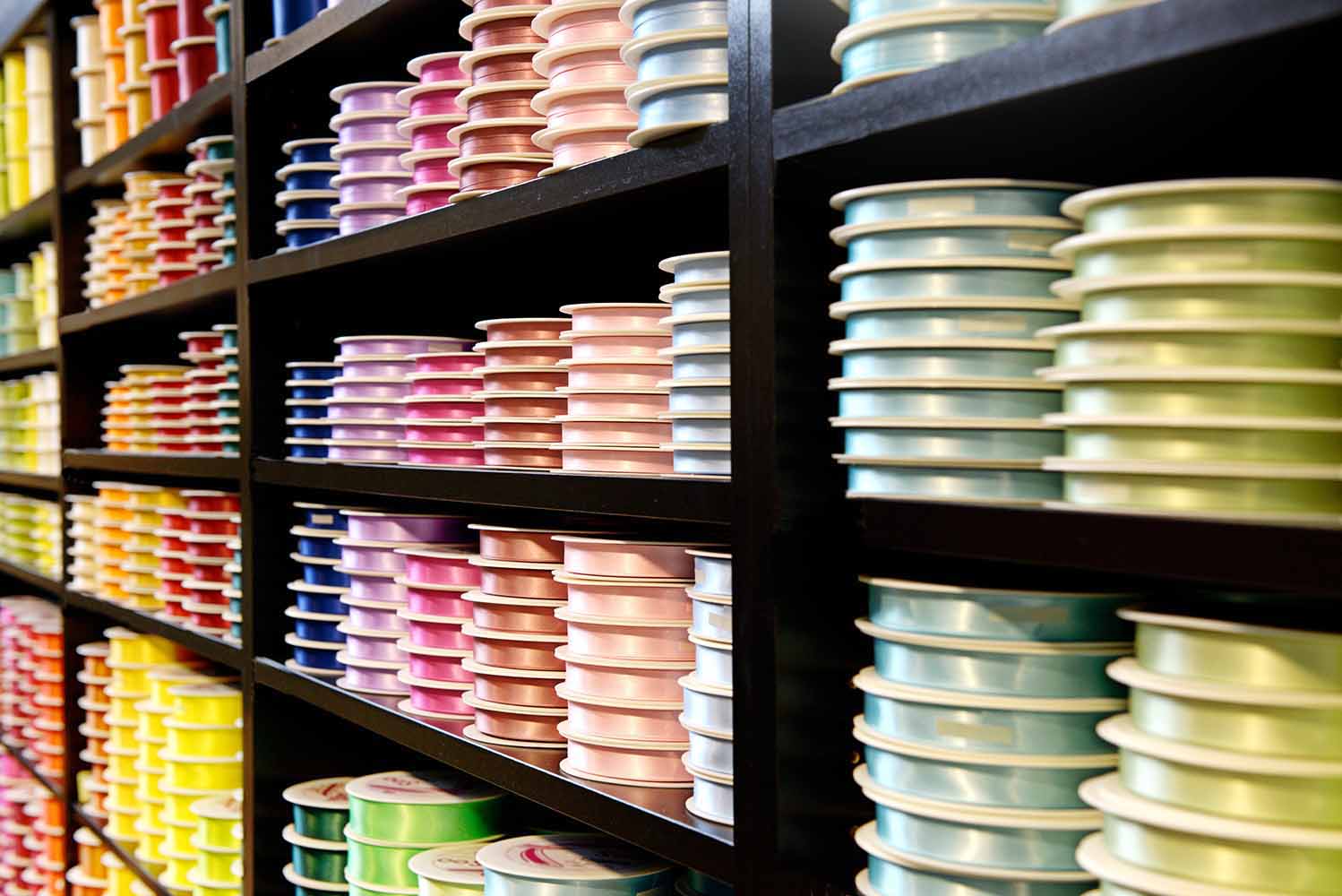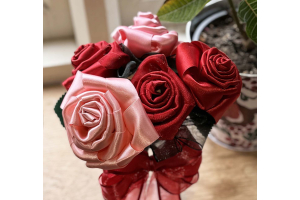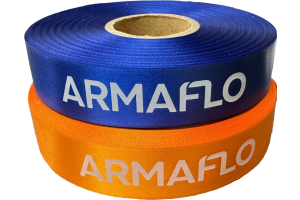
What Are Satin Ribbons, Their History, Purpose & Manufacture
Satin is a fabric that is lustrous on one side and dull on the other. It's made using a method called "sateen weave" where the threads cross over four to five picks per inch. The high number of floats on the surface gives satin its smoothing handle. It can be made from different types of fibres, including silk, acetate, nylon, and polyester. In this post, we'll explore the history of satins ribbon and what they're used for today!
What are satin ribbons and where did they come from?
Satin ribbons are a popular choice for decorations and craft projects due to their luxurious feel and sophisticated sheen. Created in China during the early 17th century, it was initially made from silk but is now often manufactured from synthetic or blended materials too. Today you will find the vast majority of satin ribbons made from 100% polyester as a cheaper alternative to its original silk beginnings.
Use of the material for decoration quickly spread across the world due to its elegant appearance and relative affordability when compared to other luxury fabrics such as velvet and silk.
Today, satin ribbons are extremely widely used in a plethora of applications from clothing to wedding decorating, gift wrapping to point-of-sale decoration, packaging to bookbinding, the list is seemingly endless.
In today's modern world, you will now find two versions of satin ribbon on offer from many spinners these are the traditional single-faced satin mentioned above as well as the modern double-faced satin ribbon. The double-faced ribbon as the name suggests has both surfaces of the ribbon finished in a smooth lustre rather than just one.
The history of satin ribbons and their many uses
Satin ribbon has a storied history of ceremonial importance, traced back to its inception in ancient China. The strong, lustrous fabric symbolized wealth and ceremony since silk was expensive and hard to acquire. It was used for garments, headpieces and wraps, carefully crafted into graceful knots, allowing the opulent colours to stand out with greatness and intensity. Brides wore ceremonial braids woven with silk ribbons as ceremonial attire during important religious events. Before long this trend had spread throughout ancient Asia and Europe alike, eventually becoming an accessory sought after by rich and powerful royalty all around the world.
Satin ribbons have been used for centuries, first appearing in Europe during the early 18th century. At this time, they were used primarily as adornments on clothing and furnishings in wealthy homes. Satin was a luxurious material that was expensive and difficult to produce, so only the wealthiest people could afford it. As more people developed the skill of weaving satin, the fabric became more widely available and its use extended to everyday items such as hair bows, ribbon trims and lace.
By the mid 19th century, satin ribbons had become popular in millinery and were used for creating decorative trims on hats, veils and other garments. While many don't give them much thought, these colourful strips of fabric have been crafted into some of the most stunning looks throughout time.
Nowadays, they are probably most often used to spruce up gift packages or add personality to special occasions. However, their original purpose was far more practical; satin ribbons were commonly used as trim on medieval garments to make them look more beautiful and elegant. They have also been a staple in the haute couture fashion industry since its very beginnings - think Grace Kelly in a vintage wedding dress with embroidered satin ribbons! No matter the use, satin ribbons will always be admired for their charm and sophistication. As they add an elegant understated finish to many item or projects.
How are satin ribbons made and what goes into their manufacturing process
Manufacturing satin ribbons requires a lengthy and intricate process, which often begins with weaving long rolls of fabric out of either silk or synthetic fibres these can be many thousand metres long. Once the fabric is woven, it must be dyed to achieve the desired colour these achieved by running the ribbon through vats of dye multiple times.
After being dyed and washed to remove the excess colour, the fabric is then pressed or passed over heated drums to give it an extra shine and luster. ~ Today's modern production process streamlines this process but still applies the exact same principles.
Lastly, after being wound around large spools, satin ribbons are finally reeled onto smaller plastic or cardboard reels which hold between 5m and 100m depending on their intended market, these are then labelled and packaged for sale. This complicated process results in a soft and luxurious ribbon perfect for any number of craft projects or formal occasions.
The different types of satin ribbon available on the market today
With the array of satin ribbons available on the market today, it is easy to find one that fits your needs perfectly. Satin ribbons come in all sizes and patterns, from tiny single-faced ones to medium-width double-faced ribbons and decorative trims the standard European widths include 3mm, 6mm, 10mm, 15mm, 25mm, 35mm 38mm, 50m, 70mm. Whilst ribbons made in the Far East & America will often replace the 10mm for 12mm the 25mm for 22mm and the 70mm for 100mm.
The thickness and stretchability of satin ribbon also vary significantly, providing you with an excellent selection for whatever project you have planned. Additionally, the colour range of satin ribbons is astounding - many companies offer hundreds of colours, including beautifully blended hues. To give you an example Brerisfords Ribbons in the UK offer a standard range of 83 stock colours but will dye a base ribbon to any Pantone shade required if you have a need for a large volume.
With so many options available to choose from, it is no wonder why satin ribbon has been a popular choice among crafters for decades.
Environmentally friendly options for polyester satin ribbons
until recently the use of Polyester satin and double satin ribbon has been questioned in some camps for its environmental credentials. However with modern technology and a willingness to find green alternatives to man-made oil-based fibre spinners are switching over to recycled alternatives.
We have written about this in past articles, but firms such as Berisfords Ribbons in the UK and some of the larger European spinners are now using 100% recycled polyester yarn which comes from plastic drinks bottles.
The bases behind this are simple, clear plastic drinks bottles are taken and shredded down into plastic pellets. These are in turn melted and the molten plastic is then extruded into very fine threads.
The threads can then be twisted (plied) together to make a yarn of the required thickness or denier for the weaving application it's being used for. This new recycled yarn is of the same quality as the virgin polyester yarn and performs, in the same way, meaning that the weavers can make the same range of high-quality ribbons in the same vast array of colours without having to compromise in any way at all, a real win-win situation.
So there you have it, a brief history of satin ribbon and all the reasons why it makes such a great choice for your next project or gift-giving occasion. With so many different types of satin ribbon available on the market today, there’s sure to be one that’s perfect for your needs. And now that you know how they’re made and where they come from, you can appreciate them even more!





 Facebook
Facebook Twitter
Twitter Pinterest
Pinterest